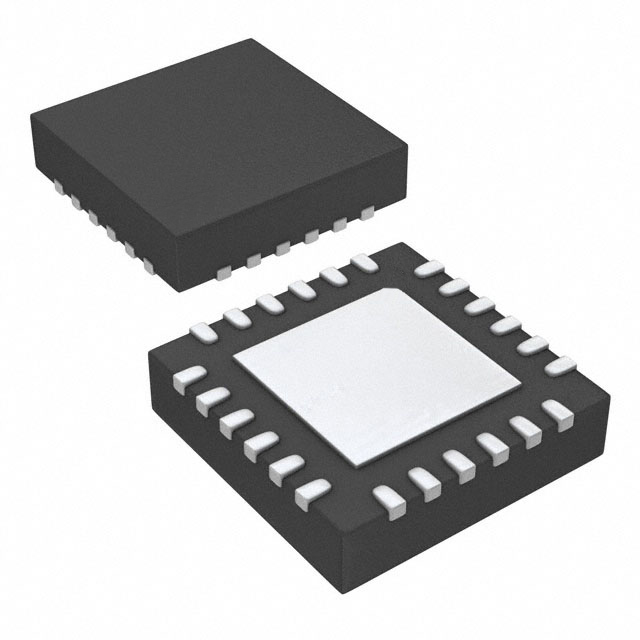Zie specificaties voor productdetails.

5P49V6965A000NLGI
Basic Information Overview
- Category: Electronic Component
- Use: Clock Generator and Jitter Attenuator
- Characteristics: High precision, low jitter, programmable output frequencies
- Package: QFN (Quad Flat No-leads)
- Essence: Provides clock signals with precise timing for various electronic devices
- Packaging/Quantity: Individually packaged, quantity varies depending on supplier
Specifications and Parameters
- Input Voltage: 3.3V
- Output Frequency Range: 1MHz to 700MHz
- Output Format: LVPECL, LVDS, HCSL
- Operating Temperature Range: -40°C to +85°C
- Supply Current: 100mA (typical)
Detailed and Complete Pin Configuration
- VDDO: Output Power Supply
- GND: Ground
- OE#: Output Enable Control
- CLK_IN: Input Clock Signal
- SDA: Serial Data Input
- SCL: Serial Clock Input
- VDD: Power Supply
- GND: Ground
- OUT0: Output 0
- OUT1: Output 1
- OUT2: Output 2
- OUT3: Output 3
- OUT4: Output 4
- OUT5: Output 5
- OUT6: Output 6
- OUT7: Output 7
Functional Characteristics
- Clock Generation: Generates multiple output clocks with programmable frequencies.
- Jitter Attenuation: Reduces the amount of jitter in the input clock signal.
- Output Format Selection: Supports various output formats such as LVPECL, LVDS, and HCSL.
- Output Enable Control: Allows individual output channels to be enabled or disabled.
- I2C Interface: Provides a serial interface for configuration and control.
Advantages and Disadvantages
Advantages: - High precision and low jitter output signals. - Programmable output frequencies for flexibility. - Supports multiple output formats. - Output enable control for power management.
Disadvantages: - Requires external configuration through the I2C interface. - Limited output frequency range compared to some other clock generators.
Applicable Range of Products
- Telecommunications equipment
- Networking devices
- Data storage systems
- Industrial automation
- Consumer electronics
Working Principles
The 5P49V6965A000NLGI operates by taking an input clock signal and generating multiple output clocks with programmable frequencies. It uses internal PLLs (Phase-Locked Loops) to generate precise timing signals. The device also includes jitter attenuation circuits to reduce the amount of jitter in the input clock signal, resulting in cleaner and more stable output signals.
Detailed Application Field Plans
- Telecommunications Equipment: Used for clock synchronization in base stations, routers, and switches.
- Networking Devices: Provides precise timing for network switches, routers, and servers.
- Data Storage Systems: Used for clock synchronization in storage area networks and data centers.
- Industrial Automation: Provides accurate timing for PLCs (Programmable Logic Controllers) and industrial control systems.
- Consumer Electronics: Used in audio/video equipment, gaming consoles, and smart home devices for clock synchronization.
Detailed Alternative Models
- 5P49V6965B000NLGI
- 5P49V6965C000NLGI
- 5P49V6965D000NLGI
- 5P49V6965E000NLGI
5 Common Technical Questions and Answers
Q: What is the maximum output frequency of the 5P49V6965A000NLGI? A: The maximum output frequency is 700MHz.
Q: Can I disable individual output channels? A: Yes, the device supports output enable control for each channel.
Q: What is the operating temperature range of the 5P49V6965A000NLGI? A: The operating temperature range is -40°C to +85°C.
Q: How do I configure the device? A: The device can be configured through the I2C interface using serial data and clock inputs.
Q: What are the supported output formats? A: The 5P49V6965A000NLGI supports LVPECL, LVDS, and HCSL output formats.
This encyclopedia entry provides an overview of the 5P49V6965A000NLGI clock generator and jitter attenuator. It includes basic information, specifications, pin configuration, functional characteristics, advantages and disadvantages, applicable range of products, working principles, detailed application field plans, alternative models, and common technical questions and answers.

